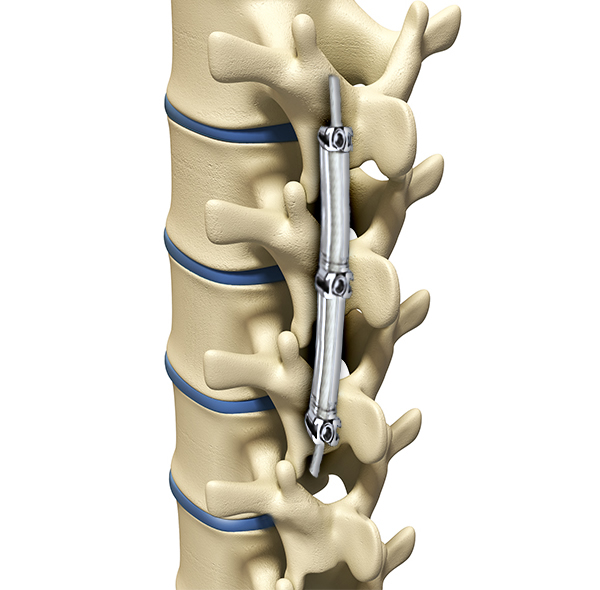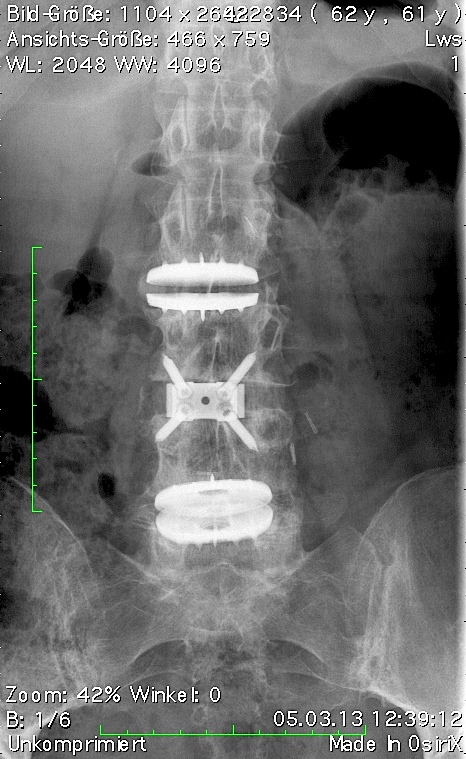
Dynamic Fixation
As an alternative to a stiffening, or fusion operation of the spine, called sponylodesis or spinal fusion, there is the possibility of dynamically reconstructing and stabilising the affected segments of the spine in a way which preserves movement. When we look at the structure, function and demands on the spine, it becomes clear how complex a structure it is. A healthy spine gives the human body completely pain-free mobility and stability. If structures in the spine are damaged as a result of degeneration, accident or damage resulting from operations, the balance between mobility and stability falls into disharmony. This dysfunction typically results in pain and is often the beginning of a whole cascade of secondary diseases of the spine. These can be:
Degenerative scoliosis
Degenerative instability
Connection instability after previous fusion
Spondylolisthesis
Spondylarthrosis
, facet arthrosis and spinal stenosis
“Failed-Back”-syndrome
Post-operative pain
A fusion operation aims to exclude the painful and unhealthy segments of the spine from the movement chain. These vertebrae are fused, and therefore immobile. Clinical studies have shown that fusion operations often can lead to painful secondary diseases of the adjacent segments. This, as well as the dreaded complication of implant loosening can make further surgical intervention necessary. These findings have led to the development of the method of dynamic fixation.
A dynamic fixation of the affected segments follows a completely different philosophy. It considers the fact that the spine can not fulfill its function without the essential interplay of “stability and movement.” The objective of surgical intervention with dynamic fixation is to preserve the mobility and function of the vertebral segments while eliminating the causes of pain. There are various implants available to the surgeon.
The viscoelastic disc prosthesis has the advantage over other implants that it ideally imitates the function of the natural intervertebral disc in its construction. Moreover, extensive laboratory tests have proven that it lasts for at least 50 years. Whether and how surgical treatment of the affected vertebral segments should be performed is planned individually by the specialist after thorough diagnostics (MRI, CT, X-ray, physical and neurological examination). If for certain reasons a partial fusion of the spine section is unavoidable, this should be limited to one segment if possible, as shown in the following example. In this way, the greatest possible functionality of the spine can be obtained or restored.
Recent clinical trials have shown that a dynamic stabilisation of the spine is a practical alternative to spinal fusion.
Dynamic Fixation – Youtube Video
The following examples provide an overview of possible options:
(1) Example of a dynamic hybrid of visco-elastic intervertebral disc prosthesis and a cage in the presence of degenerative scoliosis
Post-operative Status: Complete axial correction of the lumbar spine with two intervertebral disc prostheses and a PEEK cage. In the side view we see normal lordosis of the lumbar spine after surgery. (Spine Center Rischke)
(2) Example of a visco-elastic intervertebral disc prosthesis and dynamic fixator in the presence of spondylolisthesis


Post-operative Status: Dynamic stabilization using a hybrid of the intervertebral disc prosthesis (FLD) and dynamic fixator (DSS). (Spine Center Rischke)
Literature Bertagnoli, R., ( 2011) Hybridverfahren, in: Bertagnoli, R. et al. (Hrsg), Bewegungserhaltende Wirbelsäulenchirurgie, Urban&Fischer, München Rischke,. B. (2013) , in: Viscoelastic Lumbar Total Disc Replacement in the Treatment of Spondylolisthesis and Degenerative Scoliosis, http://www.isass.org/abstracts/isass13_regular_posters/isass13-281-Viscoelastic-Lumbar-Total-Disc-Replacement-in-the-Treatment-of-Spondyl.html Park, P., et al. Adjacent Segment Disease after Lumbar or Lumbosacral Fusion: Review of the Literature, SPINE Volume 29, Number 17, pp 1938–1944 ©2004, Lippincott Williams & Wilkins, Inc.



